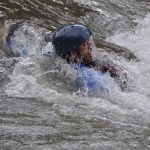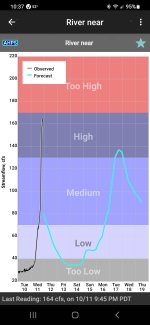I am a shit swimmer. #1 rule is don't panic.
Me too. I can swim ok, but swimming itself especially for leisure would be at the bottom of “fun“ activities for me.
Here is my Puget Sound freighter waves nightmare……
SF
I am a shit swimmer. #1 rule is don't panic.
A few years ago I took small boat sailing lessons and a prerequisite was getting checked by a lifeguard for the ability to float for a couple of minutes fully clothed, then putting on a life jacket while treading water. I wonder if the pools that do these certifications would allow me to jump in with waders and boots on? Might be helpful?I need to spend a day out on the sound just doing man overboard drills
I need to spend a day out on the sound just doing man overboard drills
Not a bad idea at all. I've done this in Westport a couple of times. Just in the marina. It is much more difficult to bring someone back onboard than I would have thought.
I should do this more often myself.

We practice this a lot in sailing, even in small boats. Super hard to lift somebody soaking wet and in gear out of the water.

Reminds me of the old Keys adage about poling towers on skiffs. There are only two kinds, ones you have fallen off of and ones you haven't fallen off of yet.Anyone who wade fishes and has not fallen in raise your hand. Now you can identify the liars by their raised hands
I’d like to hear more about what happened. Sweeper or a big sauk standing wave?I flipped my pontoon last April on the Sauk. Complete submersion. When swimming in waders you have to kick like crazy to make head way, but it can be done. Wear the PFD!
I don't take chances when wading. I use a staff. I stay where it's safe. My days of bobbing on tip toes to get across are way behind me.
Zak - As I recall from pics of your rowboat, it has high sides so there's absolutely no way you could fall out of it when leaning over to net a fish, taking a leak, having a momentary loss of balance or some such clumsy moment, right? That pfd right next to you will prevent you from being a man overboard.pfd I don't even wear one in my rowboat in calm water (it is right next to me, though).
I'm not going to wear a pfd while I'm wading. At least, not for the streams and rivers I usually fish. I don't even wear one in my rowboat in calm water (it is right next to me, though). I do wear it in my float tube (always) and in my rowboat when things seem hairy (as in, on any moving water or chop).
I'm not going to wear a pfd while I'm wading. At least, not for the streams and rivers I usually fish. I don't even wear one in my rowboat in calm water (it is right next to me, though). I do wear it in my float tube (always) and in my rowboat when things seem hairy (as in, on any moving water or chop).
I'm not wearing one wading in the river. However, I've changed a lot in the last few years otherwise. If it was warm I would run the canoe with the PFD on the floor. Almost never wore one when I wore shorts. Used to not wear one in the big boat, then a inflatable waist belt. I got the NRS for the tube, but it's so comfortable I wear it all the time in the big boat. I started wearing it bcause the kids have to wear one, now I feel naked without it. Plus, I like to go up front. My kid........... I can't force him.Zak - As I recall from pics of your rowboat, it has high sides so there's absolutely no way you could fall out of it when leaning over to net a fish, taking a leak, having a momentary loss of balance or some such clumsy moment, right? That pfd right next to you will prevent you from being a man overboard.
Sorry for the sarcasm as I don't know how many times my buddy Keith and I have had a similar discussion, he hangs his from the seat in his pram. He's tall and he's not youngster. His balance is suspect. I keep working on him to wear it. I'll shut up now! ;-)